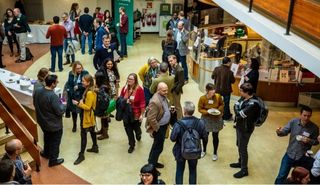University Of Reading And The Natural History Museum Host ‘Open Day’
The University of Reading and the Natural History Museum held a Research Open Day last month to launch the first phase of a long-term research collaboration. The event was inspired by the planned move of 28 million specimens – which equates to around a third of the Museum’s collection – to an ambitious new science and digitisation centre on the Thames Valley Science Park (TVSP).
The two organisations have committed to developing a wide-ranging research collaboration. The Research Open Day, hosted by the University, brought together over 100 researchers and staff to discuss potential research and training opportunities across a broad disciplinary base.
Phil Newton, Dean for Special Projects (Environment) at the University of Reading, said: “This is an incredibly exciting partnership for the University. People can see so many opportunities of how we could work together and how much progress we could make in terms of genuinely finding solutions to environmental problems and the sorts of challenges that beset the planet and our lives right now.”
The Natural History Museum’s collections house around 80 million specimens, from some of the oldest fossils evidencing the evolution of life on Earth and past environmental change to collections of bats that could help predict future pandemics. Bringing together the Museum’s collections, digitisation and imaging suites, molecular and analytics laboratories and cryo-facilities with the University’s research and teaching expertise will increase the research footprint of both institutions.
The Research Open Day included talks from colleagues across both institutions on the vision for the partnership, including plans for the use of the Museum’s collections at the Thames Valley Science Park and how collaborative research will be built into the partnership.
As well as anticipating partnerships across the University’s scientific research themes, Natural History Museum researchers are enthusiastic about Reading’s expertise in creative approaches to collections and their histories and engagement with intangible cultural heritage.
Kathryn Packer, Programme Director at the Natural History Museum, said: “We think this partnership can be a platform for a whole range of interactions – whether that’s with local people in Wokingham and Reading – or communicating and connecting with people online about the natural world.”
Conversations on the day ranged from potential research topics such as molecular uses in agriculture and the relationship between paleoclimate and evolution, to broader topics including citizen science, machine learning and potential audio visual projects.
Dominik Zaum, Pro-Vice Chancellor (Research & Innovation) at the University of Reading, said: “The Natural History Museum bringing a significant part of its collections as well as its science and digitisation facilities to the Thames Valley Science Park and developing this partnership with the University is a hugely exciting opportunity. Bringing expertise from the University and the Museum together opens up fantastic opportunities and can be a real game-changer.”
Doug Gurr, Director of the Natural History Museum, said: “We’re really excited that the University will be our partners in this, as an institution who share our passion for collections-based science, and our mission for doing something about the planetary emergency that we currently face.”

